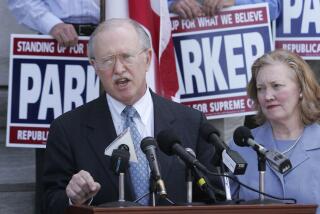Children of no one
- Share via
It’s the 1968 revolution you never heard of. Forty years ago today, tucked in between the assassinations of the Rev. Martin Luther King Jr. and Robert F. Kennedy, a U.S. Supreme Court ruling repudiated centuries of settled law by granting constitutional recognition and protection to a previously outcast group: children born outside of marriage and their parents.
The cases arose out of two private tragedies in Louisiana. Minnie Glona’s 19-year-old son was killed in a car accident. Louise Levy, a mother of five who worked as a domestic, died after a doctor failed to diagnose her hypertension uremia. Glona sued for wrongful death; so did Levy’s children.
But lower courts threw out their cases. Why? Because Louisiana law specifically blocked a parent’s recovery for the death of a child, or a child’s recovery for the death of a parent, if the child was born outside marriage. Both Glona and Levy were unmarried.
This family-law apartheid in Louisiana law had ancient roots. Under common law, a child born outside marriage used to be fillius nullius, the child of no one. In the Middle Ages, it was even a lesser crime to kill a person who had been born to an unmarried woman. In the U.S., well into the 1960s, such a child’s birth certificate might be stamped “bastard.”
In such a climate, it’s no wonder that “shotgun weddings” assured that many children conceived outside marriage were nonetheless born to a married couple. For those women who did not marry, more than 25,000 a year went to more than 200 “homes for unwed mothers,” where they gave birth secretly and usually relinquished their babies for adoption. Few admitted women who were African American, however. And mothers who did keep their children faced social stigma, discrimination in access to public benefits and laws like those in Louisiana marking the family as second-class.
But by the late 1960s, the sexual revolution was well underway. The birth control pill made it practical for women to separate sex from childbearing, and sex without marriage lost its taboo status. As the Vietnam War dragged on, “make love, not war” became one of the most resonant slogans of the decade.
Nonetheless, Louisiana fiercely defended its statutes. In its brief to the Supreme Court, it maintained that it was not trying to punish or discriminate against anyone. It declared: “Louisiana’s purposes ... are positive ones: the encouragement of marriage as one of the most important institutions known to law, the preservation of the legitimate family as the preferred environment for socializing the child. ... Since marriage as an institution is fundamental to our existence as a free nation, it is the duty of ... Louisiana to encourage it. One method of encouraging marriage is granting greater rights to legitimate offspring.”
The Supreme Court rejected this reasoning. It refused to penalize either the Levy or the Glona families with the loss of financial compensation simply because the children were born outside of marriage. Encouraging marriage and expressing disapproval of nonmarital sex were no longer constitutionally sufficient reasons to deny equal rights to children or to their parents.
Over the next several years, the Supreme Court reinforced this position, requiring states to allow nonmarital families access to public benefits and giving all children a right to financial support from their parents. When Joan Stanley died and Illinois sought to take custody of her three children away from their father, Peter, because Joan and Peter had never married, the court ruled that all fathers, not just married ones, had a constitutional right to a relationship with their children. And although that result must seem obvious today (how could it be good for grieving children to automatically remove them from their surviving parent?), it was so revolutionary in 1972 that it required every state in the country to overhaul their statutes -- more than had to do so after the landmark Roe vs. Wade abortion decision the following year.
Like so many others, this quiet revolution of 1968 is incomplete. Levy’s children were entitled to compensation for her wrongful death, but in most states today her unmarried partner still would not be. Allowing same-sex couples to marry, as California will after last week’s state Supreme Court ruling and as Massachusetts has for years, does nothing to erase the distinction between married couples and everyone else. Those who defend such distinctions may assert that they do not intend to punish or discriminate but simply want to promote marriage. It’s an argument that rings as hollow in 2008 as it did in 1968.
More to Read
Sign up for Essential California
The most important California stories and recommendations in your inbox every morning.
You may occasionally receive promotional content from the Los Angeles Times.










